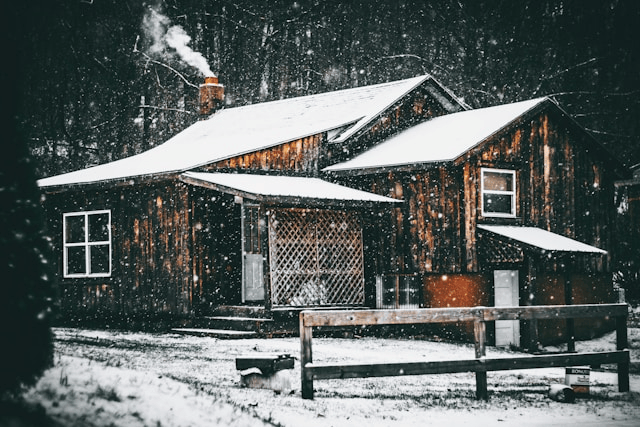As the temperatures drop and winter sets in, many homeowners are left battling cold drafts, rising energy bills, and an overall sense of discomfort in their homes. But the good news is, winter doesn’t have to mean freezing indoors or draining your bank account on heating costs. With a few strategic upgrades and mindful habits, winter-proofing your home can make a dramatic difference in how warm and cozy it feels all while helping you save money on heating.
Here’s a complete guide on how to stay warm in winter and cut back on energy expenses without sacrificing comfort.
Seal Drafts and Air Leaks
One of the easiest and most cost-effective ways to winter-proof your home is by sealing off drafts. Air leaks around doors, windows, and even electrical outlets are often the culprit behind chilly rooms and high heating bills.
Start by inspecting areas where cold air tends to creep in common trouble spots include:
-
Window frames and sills
-
Door frames
-
Baseboards and floors
-
Attic hatches
-
Chimneys and vents
How to fix them:
-
Use weatherstripping for windows and doors to stop air from escaping or entering.
-
Apply caulk to seal cracks around window frames or siding.
-
Install door sweeps to block cold air from sneaking in under doors.
-
Try foam gaskets behind outlet covers on exterior walls to prevent air leakage.
These small, inexpensive updates can significantly reduce the amount of heat lost from your home.
Insulate Key Areas
Insulation is a powerful tool in your winter defense arsenal. If your home isn’t properly insulated, you’re likely losing a large portion of your heat through the roof, walls, and floors. One of the most effective ways to reduce energy bills in winter is to insulate your home thoroughly.
Where to insulate:
-
Attics: Heat rises, so this is a top priority. Adding insulation here can yield immediate savings.
-
Basements and crawl spaces: These areas can become major sources of heat loss.
-
Walls: Especially older homes with little or no existing insulation.
Consider adding batt insulation, blown-in cellulose, or spray foam insulation depending on your budget and the area you’re working on. Even placing a thermal curtain or thick rug on a drafty floor can provide surprising warmth.
Upgrade or Maintain Your Heating System
Your heating system is the heart of your winter comfort and often the biggest contributor to your energy bill. To get the most out of your system, regular maintenance is key.
Tips to improve efficiency and lower costs:
-
Change furnace filters every 1–3 months to keep airflow clean and efficient.
-
Schedule an annual HVAC tune-up to ensure everything is running smoothly.
-
Bleed your radiators if you use hot-water heat.
-
Use a smart or programmable thermostat to set lower temperatures when you’re away or sleeping. These devices can drastically save money on heating by optimizing your schedule.
If your furnace or boiler is over 15–20 years old, consider upgrading to a more energy-efficient model. The upfront cost can be offset by long-term savings and better performance.
Maximize Natural Heat
Sometimes, the best warmth comes straight from nature. Letting the sun help heat your home is a simple yet powerful technique when trying to stay warm in winter without running your heater 24/7.
Here’s how to take advantage of natural heat:
-
Open your curtains or blinds during the day to let in sunlight especially on south-facing windows.
-
Close them at night to keep warmth inside and block out the cold.
-
Use thermal or insulated curtains for better protection.
-
Move furniture away from vents or radiators to allow heat to circulate freely.
Even small adjustments to your daily habits can make a noticeable difference in your comfort and energy consumption.
DIY Tricks for Extra Warmth
Looking for fast, budget-friendly ways to boost the coziness of your space? Here are some effective DIY hacks:
-
Door snakes (draft stoppers) block cold air from slipping under doors.
-
Apply window insulation film to add an extra layer of warmth to drafty panes.
-
Use thick rugs on hardwood or tile floors to prevent heat loss and keep your feet warm.
-
Reverse ceiling fans so they push warm air down instead of pulling it up.
-
Layer up with cozy throws and blankets, and consider wearing slippers indoors to stay toasty without cranking the thermostat.
When you combine these little efforts, they add up to a big impact on both comfort and cost.
Lower Heating Costs Without Sacrificing Comfort
You don’t have to choose between a warm home and a manageable utility bill. Here are a few smart strategies that let you enjoy both:
-
Set your thermostat to 68°F (20°C) during the day and a few degrees lower at night.
-
Use zone heating heat only the rooms you use most often.
-
Close vents in unused rooms to avoid wasting energy.
-
Bundle up with warm clothes and use heated blankets to stay cozy without over-relying on central heat.
-
Cook at home more often your oven helps warm your kitchen!
By being intentional with your energy use, you can winter-proof your home in ways that genuinely cut costs without making you feel cold.
Conclusion: Winter Comfort Made Simple
With a little preparation and a few smart changes, winter-proofing your home doesn’t have to be expensive or complicated. From sealing drafts and boosting insulation to embracing natural light and optimizing your heating system, the steps you take now can lead to a much warmer and more affordable winter.









